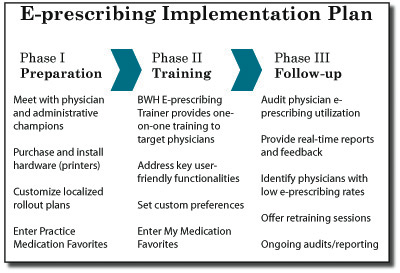E-prescribing Roll-out Continues

More and more physicians are now e-prescribing with just a few clicks of the mouse. In fact, 64 percent of current outpatient prescriptions are being done electronically at BWPO.
The LMR medication module offers physicians and patients several advantages such as improving patient safety and quality and improving physician practice efficiency. Because of this, universal e-prescribing is a significant part of Partners’ High Performance Medicine initiative.
The system provides real-time decision support by automatically reconciling new medications with a patient’s existing prescriptions and providing warnings about adverse drug-drug or drug-allergy interactions. The medication module also provides prompts for any drug-required laboratory tests and renal dosing requirements. In addition, the electronic system eliminates delays or mistakes due to illegibility issues inherent with hand-written prescriptions and eliminates pharmacy call backs to physicians.
For Jo Shapiro, MD, and the Division of Otolaryngology, it means electronically prescribing medications for patients with the safety of automatic checks for drug-drug interactions and improved record keeping.
“E-prescribing really is about doing the right thing for our patients and making our continuum of care seamless,” Shapiro said. “As specialists, we know our patient’s primary care physicians will have the same patient medication list in real time.”
In addition, BWPO physicians have pay for performance withhold dollars at risk based on the amount of e-prescribing at the Brigham.
“There are many physicians who are e-prescribing, but they may not have been trained yet on certain functionalities that would make it even quicker and easier than it already is,” said Louise Schneider, MD, BWPO associate medical director.
The BWPO and BWH are embarking on an aggressive education and training campaign to ensure that all appropriate departments and practices are e-prescribing. The Division of Otolaryngology completed its implementation last year with help from the BWPO and Partners IS LMR team.
The three-phase implementation plan includes preparation, training and follow-up. The BWPO and BWH IS collaborate with physician and administration leadership to identify specific hardware needs, such as printers in exam rooms, and customize e-prescribing for clinical users, including physician assistants and nurse practitioners. The customization includes setting up an easy-to-use list of favorites for each division or practice.
In addition, the BWPO and PHS IS representative provide training for users and identified super-users, like Lynn Kepnes, NP, in Otolaryngology. “The in-the-moment teaching done by Lynn and the availability of favorites make this work well for all of us,” Shapiro said.
Kepnes has become a big advocate for e-prescribing. “Paper is such a waste, and with all the resources BWH is committing to make us paperless, everyone should just make the switch,” she said.
In addition to Otolaryngology, training for e-prescribing is underway in Emergency Medicine and Urology, and preparation is beginning to bring e-prescribing to various departments and practices.